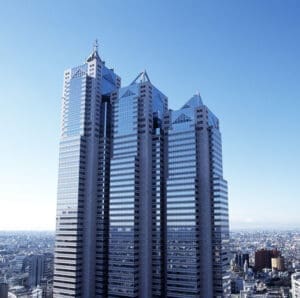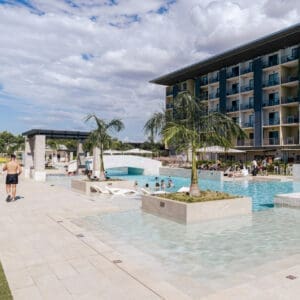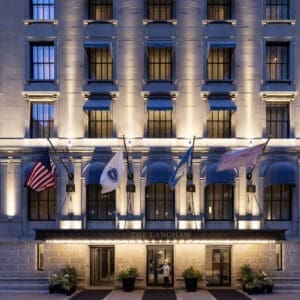
Five new additions to the exclusive Sightsleeping hotel brand have been crowned by a jury of art experts, professional designers, journalists and tourism experts. Criteria for inclusion are the attraction value and the aesthetic level of an establishment.
Only those candidates where sightseeing begins in the hotel itself can be included under the motto “Sleeping with an eye for art.” These juried hotels offer a new option in experiential travel, where arts and culture are as important in the hotel where you stay as they are in the destination visited.
“We are always looking for extraordinary hotels that qualify as Sightsleeping ones, hotels that represent an inspiring retreat for guests interested in culture and in love with design. These are hotels that spark a special feeling as soon as you awaken, a feeling comparable to that when you stand in front of a painting by your favorite artist for the first time,” explains Martin Spantig, managing director of BAYERN TOURISMUS Marketing GmbH.
The new hotels in the Sightsleeping portfolio are:
- Brauereigasthof Hotel Aying noted for combining style and individuality with a special flair
- Das Kranzbach, a historic hotel and spa refuge in the heart of the Upper Bavarian mountains
- GutsAlm Harlachberg, set among the nature of the Bavarian Forest in a truly special way
- Dennenlohe Palace, surrounded by a fairytale park of rhododendrons in Franconia
- Schloss Blumenthal, a hotel co-designed by artists and situated in the heart of an idyllic palace complex in Bavarian-Swabia
To meet the high standards of guests and guarantee the quality of the brand, the expert jury has developed strict criteria for a hotel to be accepted.
“An establishment that wishes to become part of Sightsleeping Hotels must have an individual character, standards that are over and above the norm, and a coherent and appealing overall concept. It is not enough to provide a stylish, modern, urban design, as the majority of chain hotels currently offer,” notes jury member Deborah Gottlieb, deputy editor in chief of Das Feinschmecker magazine. “In the case of historic buildings, it may be the way the building’s own history is referenced, for example, with original furnishings throughout the house which fit in with the overall look. Contemporary buildings should offer modern design concepts and a certain je ne sais quoi,” she continued.
Brauereigasthof Hotel Aying: a feeling for tradition and a fine sense of detail
Its presence was first mentioned back in 1385, and since then, the family-run, four-star superior hotel Brauereigasthof Hotel Aying has developed into a stylish holiday residence, one in which design meets modern comfort, and precious signs of the past have been carefully preserved. An incomparable experience has been created over the last 600 years with the inn and manor house, the Museum Sixthof, and the hotel’s own Aying brewery. The individually designed rooms with a historical ambience and the cozy library with open fire provide guests with a special place in Bavaria.
Das Kranzbach: an English country house in the heart of the Bavarian mountains
Surrounded by the peace and quiet of the mountains and the lush green of the meadows, with imposing rock faces in Klais near Garmisch-Partenkirchen, British aristocrat Mary Isobel Porter built a country house in an arts & crafts style 100 years ago. Today Das Kranzbach is a four-star wellness and leisure hotel, an oasis of calm. The harmonious interior design of the historic main house was created by Ilse Crawford of London. The house’s rooms, which are flooded with light, have been fitted with lots of wood and glass, as well as other natural materials.
GutsAlm Harlachberg: using nature as the architect
Peace and quiet, solitude, tradition and modern comforts all come together in this setting. On the expansive land of the GutsAlm, the award-winning architecture impressively demonstrates how delicately it can fit with nature. A group of buildings has been created in which the principles of simplicity and naturalness combine harmoniously with centuries-old mountain traditions in the Bavarian Forest. The four-star GutsAlm Harlachberg is surrounded by a chapel from the 17th century, an old farmhouse, a lovingly restored art nouveau villa, and three romantic meadow chalets at the forest’s edge.
Dennenlohe Palace: a fairytale ambience surrounded by rhododendrons
When Baron and Baroness Süsskind opened the doors of their baroque palace, which dates back to 1734, they fulfilled the dream of many of staying in a palace. A magnificent park of rhododendrons surrounds Dennenlohe Palace. A look behind the palace walls shows the private lounge with fireplace, newly restored guest rooms, and 25 hectares of romantic landscaped gardens. Revealed within the context of the present are the palace’s many stories from its past such as visits by notables including nobleman Furst Puckler.
Schloss Blumenthal: art, culture and indulgence in the Wittelsbacher land
Schloss Blumenthal is a creative hotel in the heart of a palace complex, set in the heart of the countryside and run by a cooperative based on the principles of ecology and health. Filled with cultural artifacts, the rooms in the manor house are extraordinary works of art. Fifteen Blumenthal artists have designed each room individually. Here guests stay in what is essentially a work of art that inspires you as soon as you open your eyes. In the Schloss Blumenthal inn in the Bavarian-Swabian town of Aichach, guests are treated to Bavarian specialties and creative vegetarian delights in an idyllic setting.















